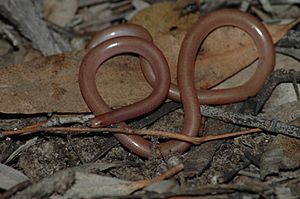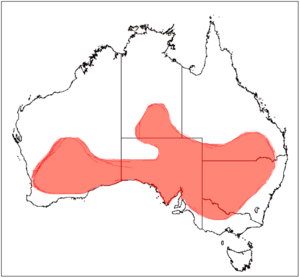Prong-snouted blind snake facts for kids
Quick facts for kids Prong-snouted blind snake |
|
|---|---|
 |
|
| In Hattah-Kulkyne National Park | |
| Conservation status | |
| Scientific classification | |
 |
|
| Estimated range of A. bituberculatus | |
| Synonyms | |
|
The prong-snouted blind snake (Anilios bituberculatus) is a special type of snake. It is not venomous, meaning it's not dangerous. This snake is like a worm and lives underground. It belongs to a family of snakes called Typhlopidae. You can only find it in central and southern Australia.
Contents
What Does It Look Like?
This snake is small and thin. It has shiny scales. Most of them are about 30 centimeters long. The longest ones can be up to 45 centimeters.
Its back is brown or black. Its belly is creamy white or pinkish white. The snake's body is the same thickness all the way along. It ends with a very short, pointy spine.
It has small, dark eyes. They are hidden under the scales on its head. Its mouth is small and curved. It's located behind and below its snout, a bit like a shark's mouth. The snout itself looks like it has three bumps when you see it from above.
About Its Name
The prong-snouted blind snake is one of 46 types of blind snakes. These snakes belong to the group called Anilios. Its scientific name, A. bituberculatus, is the most common one used today.
Where It Lives and How It Behaves
It's hard to know exactly where these snakes live. This is because they spend most of their time hidden underground. They are good at living in dry places. You can find them in different areas across southern Australia. This includes coastal parts and drier inland regions.
They live in states like New South Wales, Northern Territory, Queensland, South Australia, Victoria, and Western Australia. Blind snakes are often found when people dig up termite or ant nests. This is because the snakes move through the tunnels these insects make.
Sometimes, you might see them on the ground at night. This often happens after it rains or when the weather is warm. If they feel bothered, they might let out a strong smell. This smell comes from special glands near their tail. It helps them scare away danger.
Reproduction
The prong-snouted blind snake lays eggs. This means it is an egg-laying animal. Females usually lay about six eggs at a time. They can lay anywhere from two to nine eggs. Once the young snakes hatch, they are on their own. They must find food and protect themselves.
What It Eats
Since the prong-snouted blind snake lives underground, it mostly eats tiny insects. It loves to eat the eggs, young (larvae), and cocoons (pupae) of ants and termites. The snake uses its upper jaw to scoop this food into its mouth. Then, it swallows the food whole.
Conservation Status
Right now, there are no special plans just for protecting the prong-snouted blind snake. However, it does live in some protected areas.
Some animals like night-hunting birds of prey, such as owls, eat blind snakes. Feral cats and foxes also hunt them. Other snakes, especially the bandy bandy, also eat them. The prong-snouted blind snake is not currently considered to be in danger. Still, some places where it lives might be harmed by human development.
Images for kids







